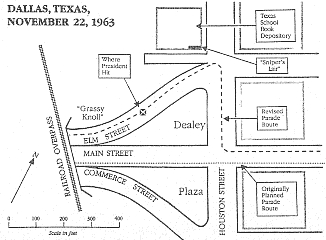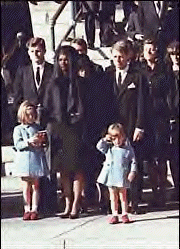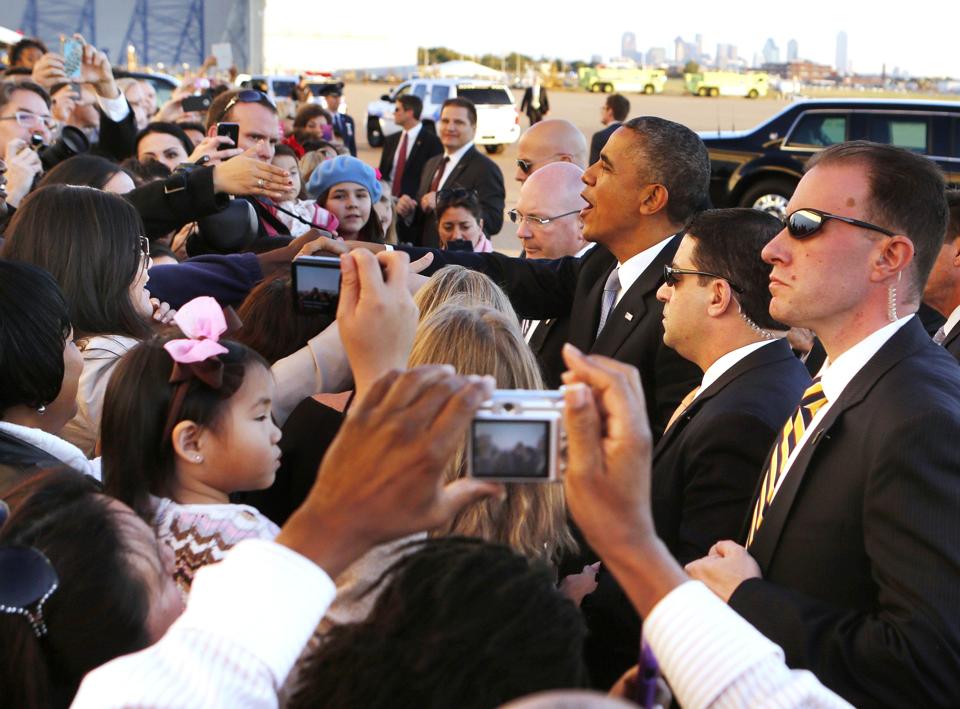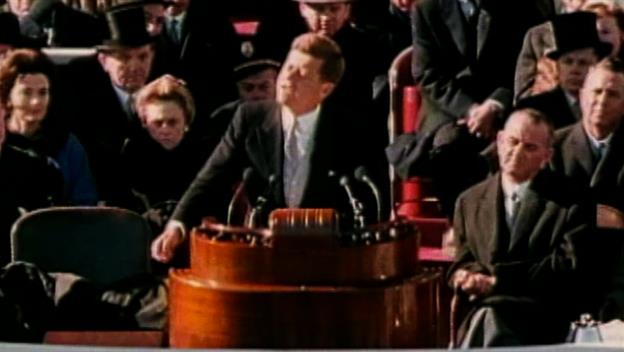 President
Kennedy's trip to Dallas in November 1963 was part of larger campaign stop
leading up to the 1964
election. Though Texas
went for Kennedy in 1960, it
was by a margin of 2 points. Kennedy made
a stop in Houston, San Antonio, Fort Worth, and was
scheduled to speak at the Trade Mart in Dallas. After Dallas, he was
scheduled to address Democratic Party supporters in Austin and spend the night
at Vice-President Johnson's ranch.
President
Kennedy's trip to Dallas in November 1963 was part of larger campaign stop
leading up to the 1964
election. Though Texas
went for Kennedy in 1960, it
was by a margin of 2 points. Kennedy made
a stop in Houston, San Antonio, Fort Worth, and was
scheduled to speak at the Trade Mart in Dallas. After Dallas, he was
scheduled to address Democratic Party supporters in Austin and spend the night
at Vice-President Johnson's ranch. While
riding in a presidential motorcade with Texas Governor John Connally through
Downtown Dallas on Friday 22 November 1963, shots from an assassin pierced
through the clear sky as the limousine drove through Dealey Plaza on Elm Street
past the Texas School Book Depository building. One bullet struck Governor
Connally in the shoulder, two others struck President Kennedy in the neck and
head.
While
riding in a presidential motorcade with Texas Governor John Connally through
Downtown Dallas on Friday 22 November 1963, shots from an assassin pierced
through the clear sky as the limousine drove through Dealey Plaza on Elm Street
past the Texas School Book Depository building. One bullet struck Governor
Connally in the shoulder, two others struck President Kennedy in the neck and
head.
The
motorcade sped to Parkland Memorial Hospital to save the life of the wounded
president. At 1:38 PM (CT), Walter Cronkite of CBS News had the grim duty to
report that President
Kennedy was dead.
Meanwhile
in Dallas a manhunt was underway for the assassin. Lee Harvey Oswald was
apprehended at a Dallas theater and charged with two murders: the assassination
of the president and the murder of Dallas police officer J.D. Tippit. The
weapon in the assassination was a 6.5 x 52-mm Italian Carcano M91/38
bolt-action rifle and was purchased in the mail by Oswald for $12.78.
The rifle that police believe killed President
Kennedy was bought by mail order in Chicago for $12.78, reports ABC
News.
— Today in 1963 (@todayin1963) November
22, 2013
The
newly sworn in president addressed the shocked nation with this speech:
The
global response to the assassination was unprecedented as the
world gave their support to a grief stricken nation. Even the Soviet Union
expressed their condolences to the slain American president calling him "an
outstanding American statesmen."
His
widow, Jacqueline Bouvier Kennedy, lit the eternal flame as a memorial for her
husband. She would later marry Aristotle Onassis, a shipping magnate, and
pursue a career in publishing. She passed on 19 May 1994 due to complications
of non-Hodgkin's lymphoma.
While
the funeral of President John F. Kennedy was going on, Lee Harvey Oswald was shot
by nightclub owner Jack Ruby while Oswald was being transferred from police
headquarters to the county jail. The crime was caught on live television. Oswald was rushed to Parkland Hospital where he died of wounds sustained due to the gunshot. Ruby was charged and tried in the murder of Oswald. He was convicted and sentenced to death on 14 March 1964, but his attorney argued that Ruby could not receive a fair trial in Dallas. The Court of Criminal Appeals awarded a change of venue to Wichita Falls and ordered a new trial to begin in February 1967, but Ruby died of complications due to liver and brain cancer in December 1966.
President
Johnson commissioned a fact finding mission of who was behind the
assassination. The Warren Commission, named after Supreme Court Justice Earl Warren who was the
chair, determined that Oswald acted alone in conspiring to murder President
Kennedy. Other well known names associated with this commission include Georgia
Senator Richard Russell, former CIA
director Allen Dulles,
then-Republican House leader Gerald Ford, and Arlen Specter who served
as an assistant counsel to the commission.
There
has been debate about the findings of the Warren
Commission. People have speculated that there were multiple shooters and there was a much larger
conspiracy involving elements of the CIA, military-industrial complex, Mafia,
Soviet Union and the KGB, lizard people, and even President Johnson were all behind
the Kennedy assassination.
This
blog is not to discuss conspiracy theories. If you wish to do so, might I
suggest one of the many underpasses in downtown Dallas to rant those insane
theories there are other forums to discuss that online. I believe that
people like going down the Kennedy assassination conspiracy theory rabbit hole
because it is comforting to believe that some sinister organization could be
behind the murder of someone that we idolize and hold in high esteem.
Maybe
Occam's razor holds
true that Oswald was the lone gunman and perpetrated the crime. Again,
sometimes the simplest explanation is the most obvious explanation. Like
how Obama won Ohio and he really was born in Hawaii. And the Bureau of Labor
Statistics did not make up a fake unemployment rate before the 2012 election. And
FEMA is not building concentration camps. And the moon landing was real. And UN
election observers are not taking over Texas. And the modest reforms to the
insurance and financial industries are not the same thing as communism.
This
would not be the last tragedy to happen to the Kennedy family. After winning
the California Democratic Party Primary in June 1968, New York Senator Robert
Kennedy was struck down by an assassin's bullet. Even though Ted Kennedy had a distinguished
career as a senator fighting for universal health care and education reforms, a
car accident on Chappaquiddick Island cost the life of his passenger and nearly
ended his political career due to his fleeing the scene of the accident. John F. Kennedy, Jr.
along with his wife and her sister were killed in a plane crash off the coast
of Martha's Vineyard in July 1999.
The
Kennedy family is still active in American politics. Joseph P. Kennedy III
is a member of Congress from Massachusetts holding the same seat occupied by
Barney Frank. Robert
F. Kennedy, Jr. is involved in environmental activism. The daughter of
President Kennedy and First Lady Jacqueline, Caroline, was an early
supporter of Barack Obama's presidential campaign and was a keynoter at the 2008 DNC
introducing her uncle Ted. Today she is our
ambassador to Japan. It should be noted that her father was making plans to
be the first sitting American president to visit that country.
President
Kennedy's death was a loss on so many levels. WFAA/ABC-8 showed a replay of the
president arriving in Dallas on that fateful day on Friday. One thing I noticed
when the president arrived at Love Field was the size of the crowd and the
number of people who were chasing the motorcade as it went to downtown Dallas.
Here
is a picture of President Obama and video of the motorcade when he has visited Dallas.
The crowd is bit more controlled. An entire convoy of security and medical personnel
travels with the president when he leaves the White House. Some of those protection
measures are part of heightened
security taken after the Kennedy assassination, the attempted Reagan assassination
in March 1981, and the 9-11 attacks.
We
are still feeling the effects of the assassination to this day. A lot of the
politics of today are shaped by what happened in Dallas 50 years ago. The
Johnson administration was in the shadow of Kennedy. They tried to forge its
own legacy with establishing Medicaid, fighting poverty, and expanding voting and
civil rights but President Johnson is most remembered as escalating America's involvement in Vietnam. The
1960s is remembered where the counter-culture reached its peak and clashed with
the establishment. Richard Nixon ran and won as an establishment candidate in
1968 and was re-elected in 1972 by courting whites alienated by the liberal
direction the Democratic Party took, especially those in the south. Nixon would
resign over Watergate in 1974, but the country continued drifting in a
rightward direction with the election of Reagan in 1980 followed by his two
terms and then the establishment of the Bush family as the premier political
family in this country.
I've
read a couple of articles (ABC
News, Yahoo,
Huffington
Post, Dallas
News, NY
Times from 2003, Washington
Post book review) around the topic of "What if the weather in Dallas
stayed dreary that day."
So
far the consensus appears that Kennedy might not have made the same decisions
about Vietnam in the same way that Johnson did. Kennedy probably does not
achieve the same meaningful civil rights legislation and expansion of the
social safety net that his successor did which led to the southern wing of the
Democratic Party to start defecting to the Republican Party in the late 1960s-early
1970s.
I
believe that the counter-culture of the 1960s still would have happened if
President Kennedy lived, but it would have taken on a different tone possibly galvanizing
over racial and gender equality instead of the Vietnam War.
It
is possible that Kennedy's personal life would have dominated the headlines later
on in this proposed second term, but the media had the events of Vietnam
and Watergate to sharpen its investigative tools. Maybe in this alternative
timeline Kennedy's indiscretions is the equivalent to Watergate.
In
some of these alternative timelines, they speculate that Robert Kennedy
continues the Kennedy dynasty being elected president in 1968. I'm not sure
that it is possible to reach that conclusion because Robert Kennedy clashed
with President Johnson in 1964 and left to run for the US Senate that November.
Would have Robert Kennedy stayed on as attorney general or would the break with
the White House been more amicable if President Kennedy lived?
Another
idea is proposed by Steven King in his time traveling book 11/22/63 is
that the pro-segregationist candidate George Wallace running as a Democrat wins
leading to Vietnam turning nuclear and the world turned into a post-apocalyptic
atomic wasteland. While King's book is a tad extreme, he raises a good point
about how presidential politics swing from left to right in at most a ten year
period. After the Democrats held the White House for 20 years through FDR and
Truman, Eisenhower as a Republican was president from 1953-61. That was
followed by the Democrats with Kennedy and Johnson from 1961-69. Nixon and then
Ford from 1969-77 followed by four years of Carter, 12 years of Reagan-Bush,
then eight years of Clinton (1993-01) and W. Bush (2001-09) with their own two
terms, and we arrive at the Obama presidency (2009-17). Since the enactment of
the 22nd
Amendment, it appears that one party does not hold the White House for
longer than 15 years.
While
interesting to explore the topic of alternate history and timelines, it does
not change what really happen.
I
close with these words from Kennedy's
inaugural address to point out to instead of imagining of what could have
been to making what should be a reality.
So
let us begin anew -- remembering on both sides that civility is not a sign of
weakness, and sincerity is always subject to proof. Let us never negotiate out
of fear, but let us never fear to negotiate.
Let
both sides explore what problems unite us instead of belaboring those problems
which divide us.
Let
both sides, for the first time, formulate serious and precise proposals for the
inspection and control of arms, and bring the absolute power to destroy other
nations under the absolute control of all nations.
Let
both sides seek to invoke the wonders of science instead of its terrors.
Together let us explore the stars, conquer the deserts, eradicate disease, tap
the ocean depths, and encourage the arts and commerce.
Let
both sides unite to heed, in all corners of the earth, the command of Isaiah --
to "undo the heavy burdens, and [to] let the oppressed go free."
And,
if a beachhead of cooperation may push back the jungle of suspicion, let both
sides join in creating a new endeavor -- not a new balance of power, but a new
world of law -- where the strong are just, and the weak secure, and the peace
preserved.
All
this will not be finished in the first one hundred days. Nor will it be
finished in the first one thousand days; nor in the life of this
Administration; nor even perhaps in our lifetime on this planet. But let us
begin.






No comments:
Post a Comment